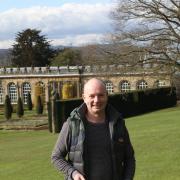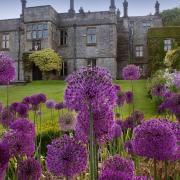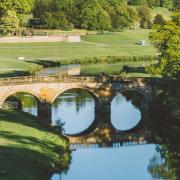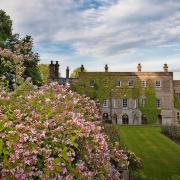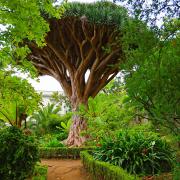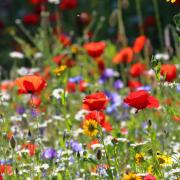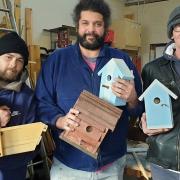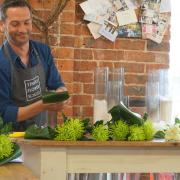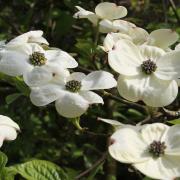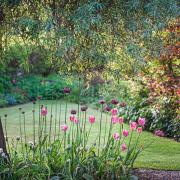Pat Ashworth looks around the garden of Simon and Lucy Thompson
There has been a house on the beautiful site of Culland Hall, Brailsford, since the 12th century. Simon Thompson’s father was a young man in his twenties when he bought the place in the late 1930s, which explains why (putting aside dry rot), he had the courage to knock down something he considered to be incredibly ugly and start from scratch to build a new one. The walls were just two foot high when the Second World War broke out, and he told the builder he might as well forget about it. But warned that materials would be scarce and the cost of everything sky-high by the time war ended, he had the house built in his absence while he went off to fight. ‘He never saw it at all while it was being built, but he intended it to last for ever,’ says Simon’s wife, Lucy. It is south-facing and stands in a quintessentially English landscape, a park laid out in the late eighteenth or early nineteenth century. The garden drops gently down to a shallow valley with a lake and the broad fields rise up to a skyline of trees on the other side. House and garden look as though they have been wedded together from the start, an appearance that belies just how hard the couple have worked to make that happen. They came back 15 years ago from a spell in America, during which Simon’s father died. He had been interested in the farm, which Simon now runs, but not particularly in the garden, and Lucy welcomed the opportunity for the couple to put their own footprint on it. They re-laid the terrace and restored the ha-ha but in changing the whole structure and shape of things and in order to get healthier stock, made a point of not planting in the same places. They extended the lake, to make it a size and depth that meant it would not need constant dredging. Lucy reflects of the surroundings, ‘For me, it’s very important to keep the garden in harmony with the landscape. It’s so English that to go into another style just wouldn’t be appropriate.’ Brought up in Kent, she was deeply influenced by the gardens at nearby Sissinghurst Castle. The idea of dividing a garden into ‘rooms’ had appealed to her from an early age and she created her first white garden at the age of 12. The ‘rooms’ in the Culland Hall garden are protected by tall yew hedges to block the gales that sweep across the fields and to provide an all-year-round outline. ‘This view is stunning,’ she acknowledges, ‘but you can imagine what it’s like when the westerlies come up.’ She loves this feeling of going into different spaces, and wanted ‘something different to look at in different parts of the garden’. The first room is a rose garden, the beds strikingly and beautifully edged with formal box hedges. ‘They’re generally
old roses, some of them dating right back to the medieval period,’ she says with pleasure. ‘It’s an intimate space, full of pinks, deep burgundy, wine and claret colours – I do so love roses.’ This room is divided from the next by a building and archway that look positively medieval – ‘an extraordinary whatever ... a folly maybe,’ Lucy comments. A well head stands in the next area, the box-edged white garden. It’s a sheltered and enchanting spot for dining out under a clematis arch on summer evenings, as well as drinking in the sight and scent of white roses, anemones, lilies, phlox, allium, meleanthus major and irises of many different varieties. A different picture presents itself as we move into the next room, once an orchard garden with a mellow brick wall running its length. The apple trees gradually died here, and when the last one went, Simon and Lucy decided to create a deep border in front of the wall. ‘When we started digging, all these Edwardian plant labels came up. So there had been a border there already,’ she says with pleasure. It sports late summer plants like Limelight Hydrangea with its bright green blooms in summer and deep pink in the autumn. When the yew hedge that now confronts us grows as tall as the brick wall of the old orchard, it will be the beginning of a garden that incorporates a woodland walk created by Simon’s mother on the footprint of an even earlier one. The atmosphere is different now, less formal, a semi-wilderness of acers, azaleas and rhododendrons and of rare and unusual trees and shrubs from the nearby nursery of Robert Vernon. ‘It has been wonderful to have that source very close by,’ she observes. A pinus cerulea is her particular favourite with its silken texture and spectacular peeling bark, especially against a background of gleaming holly. There are 12 varieties of magnolia here too. Dogtooth violets planted are ‘hopefully taking’, along with other special bulbs but Lucy has had no need to plant snowdrops – a favourite of her mother-in-law, who put in many hundreds. Now comes the gently sloping kitchen garden with its three rotational beds, the soil raked up as the Victorians did, to get the maximum heat from the south. The borders here are hot borders – ‘clashing reds, oranges and yellows which really go with a kitchen garden,’ Lucy says. The long pergola was constructed eight years ago when a large oak came down on the farm and is covered with rambling roses, complemented by a border of riotous dark pinks, pale pinks and whites. Peaches grow against a wall which, when the Thompsons returned from America, was being held up only by a decaying greenhouse. The entrance to the old house was at what is now the back, the southern aspect. Simon’s father reversed that for the new house. Chionanthus virginicus trails up the walls from the terrace, flowering even in the middle of winter: in summer, its heady perfume wafts up to the bedrooms above. ‘It’s one of our favourites. The scent is just the most beautiful thing,’ Lucy says in appreciation. Back door and front door are now both on the north side of the building, where [Catherine Robey*], a plantswoman who gardens three days a week at Culland Hall, is spreading rich, three-year old manure on a bed that was once grass. ‘The hens get very excited about it,’ she says as the rare breed birds scratch and cluck their way through with evident pleasure. These hens are so happy they have laid throughout the hard winter, oblivious of the old adage about not laying between Bonfire Night and St Valentine’s Day. Catherine and Lucy have been working together on the garden for eight years. Lucy praises Catherine’s ‘encyclopaedic’ knowledge of plants and describes her as a driving force. ‘We’re a good partnership, we’ve got similar tastes and we work together for the same ends,’ she says. The annual Plant Fair at Culland Hall takes place on the last Sunday of April and is the goal that keeps both women motivated to put on the to-do list even the ongoing things they ‘might otherwise not get round to ever.’ They make their own compost – five bins are on the go – and use practically no sprays, preferring to feed the soil so that the plants are as strong and healthy as can be and fight off disease through their own immune system. ‘We hardly water, either: things have got to stand on their own feet really. That’s why I like buying them in the spring,’ Lucy observes. ‘It’s not very environmentally sustainable to water, and not necessary if you can plan your planting. Roots grow down to find water – if you keep watering them they will grow to the surface where the water is, and you have a self-perpetuating problem.’ Every year she and Catherine say they’ll consolidate and not take on a new project, and every year they can’t resist it. They have turned their attention this year to a large, semi-wooded area at the eastern side of the house, where they have planted 3,000 fritillaria for the spring. ‘We’re not going to make a wildflower area because the soil is too rich, but hopefully things will happen,’ Lucy says. Paths will be mown through long grass to create a slightly more naturalistic, wilder part of the garden, and Simon, who loves trees, has planted some unusual oaks here.
The coach house dates from 1649 and sports a mass of Lucy’s favourite rose, the [name of variety]. ‘It’s the earliest to come out and it’s absolutely beautiful, with tiny, fluffy, apricot-yellow flowers that cover the whole wall and look stunning,’ she says with pleasure. It should be out by the time of the Plant Fair, and it’s almost the first thing visitors will notice. They come to the Fair in their hundreds, 400 in just the first hour last year. All proceeds go to the Mid-Derbyshire Association for Mobile Physiotherapists, set up 30 years ago to provide a van and to pay for physiotherapy for elderly patients who would otherwise have to be taken in an ambulance for hospital appointments. Many have had strokes or falls. ‘It enables them to stay in their own homes if they want to, and most do,’ Lucy says, paying the warmest of tributes to the physiotherapist, Beverley Withers, who ‘looks at patients in a holistic way and is patient and kind.’ Local Scouts receive a donation for helping with the event, parking cars in the fortunately well-drained fields and barrowing purchases back to people’s cars. Stallholders love the hospitality, from bacon butties on arrival to refreshments throughout the day. So do the hens, who ‘like cakes being marched around, and cottoned on to that very quickly.’ Simon will have been preoccupied with lambing of the farm’s 300 pedigree ewes throughout March: all she needs now, concludes Lucy, is ‘a spell of fine weather. Please.’
Culland Hall’s Plant Fair is on Sunday 25th April from 11am-4pm



